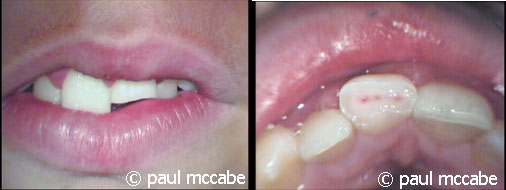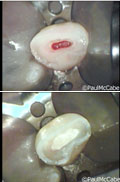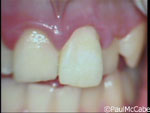Trauma Advice
Three types of trauma examined:
THE FRACTURED TOOTH
-
LOCATE MISSING TOOTH FRAGMENTS AND BRING THEM WITH YOU.
-
SEEK IMMEDIATE DENTAL TREATMENT
Some times the trauma can be relatively minor and only one or two teeth may be affected. There may not be a lot of associated pain. There are various types of fractures. This case illustrates a fracture involving enamel dentine and pulp in a young boy with no previous fillings.

The above image shows the initial presentation of a maxillary left central incisor which has just been fractured. Examination of the tooth shows that the fracture involves enamel, dentine and pulp. Prior to the accident the tooth was perfectly intact there were no previous restorations/fillings done therefore the pulp was perfectly healthy. Note that this tooth was a little more prominent than the adjacent teeth making it more susceptible to trauma.
 The image to the left shows the radiographic view of the same tooth showing a crown fracture involving enamel dentine and pulp. No other complications are detected.
The image to the left shows the radiographic view of the same tooth showing a crown fracture involving enamel dentine and pulp. No other complications are detected.
If this injury to the tooth remains untreated for a significant period of time it is probable that the tooth will require a root canal treatment which would be the normal treatment for such a situation. However, if immediate treatment is initiated, it may be possible to preserve the pulp and avoid the root canal treatment.
 Under local anaesthetic and rubber dam isolation the superficial layer of the pulp is removed. This layer has been exposed to the external environment and will have been contaminated as a result. Removal of this layer removes the bulk of the contaminants and offers the pulp the best healing opportunity. The pulp shows a normal healthy response to this treatment.
Under local anaesthetic and rubber dam isolation the superficial layer of the pulp is removed. This layer has been exposed to the external environment and will have been contaminated as a result. Removal of this layer removes the bulk of the contaminants and offers the pulp the best healing opportunity. The pulp shows a normal healthy response to this treatment.
This is then capped with a biocompatible material such as MTA or Calcium hydroxide.
The original tooth fragment was re-attached in this case. This makes a very nice short to intermediate term restoration. Even if there are some tiny fragments of tooth missing these gaps can be filled in with white filling material. Post operative x-ray/radiograph showing the pulp capping in place (arrow) with the attached fragment.
Post operative x-ray/radiograph showing the pulp capping in place (arrow) with the attached fragment.
The tooth will require reassessment over the following 6 – 12 months to ensure healing is uncomplicated.
Emergency Steps for Saving a Knocked-Out Tooth
Both adults and children are at risk. With proper emergency action, a tooth that has been entirely knocked out of its socket often can be successfully replanted and last for years.
-
Locate the tooth. Pick it up. Handle it by the crown only (part which is normally visible in the mouth as opposed to the root which is embedded in the gum).
-
If dirty gently rinse the tooth with water. Avoid touching the root if at all possible.
-
Do not use any soap, detergents or chemicals to wash the root
-
Do not scrub the root.
-
Do not wrap the tooth in paper or cloth towels.
-
Do not dry the tooth.
-
-
Reposition the tooth in the socket as soon as possible. The sooner the tooth is replaced, the better it will survive. To reinsert the tooth, gently push the tooth into the socket with fingers. Hold it in place by gently bringing the top and bottom teeth together. The tooth should fit back into the socket exactly in most situations.
-
If it is not possible to put the tooth back into the socket then it should not be left to dry out
-
Place the tooth in a tooth preservation kit.
-
Place the tooth in the mouth next to the cheek.
-
Place the tooth in milk.
-
-
Seek immediate dental care. Ideally within 30minutes.
Dental inuries are often very frightening to look at, but with the proper attention a hopeless situation for a young patient can be turned around and teeth which would otherwise have been lost can be retained and restored. In all trauma cases the prognosis for these teeth remains guarded long term.
More Significant Injuries
Information coming soon
Patient Login Area
Patient Advice
Post Treatment Advice
Useful information for patients following treatment.
Post Surgical Advice
Useful information for patients following a surgical procedure.
Trauma Advice
Information for patients following in the event of a dental trauma.
Preventative Advice
Information for patients to help prevent dental problems.


